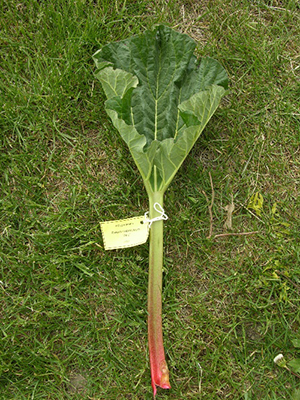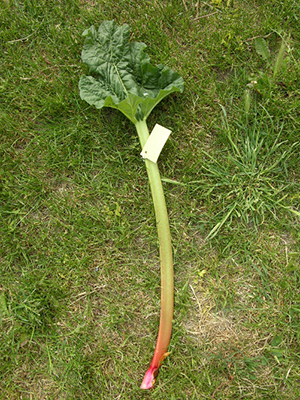Rheum rhabarbarum L. (Polygonaceae)



| ENG | rhubarb, garden rhubarb |
| SK | rebarbora vlnitá |
| CZ | reveň kadeřavá/rebarbora |
| PL | rzewien |
| HU | rebarbara |
Using
Rhubarb was first grown in gardens for medicinal purposes, bud then began to be eaten as a food. The two main medicinal species of rhubarb are R. palmatum and R. officinale or hybrids of two species. The dried subterranean organs contain antraquinone glycosides and are used as a laxative. Leaves are harmful if eaten. The roots of edible rhubarbs (R. rhabarbarum, R. x hybridum) can not be used for medicinal purposes. R. rhabarbarum is used for its edible petioles as delicate vegetable.
Garden rhubarb contains vitamins C and K, as well as magnesium, calcium, potassium and manganese. It is also rich in fibre. Rhubarb contains oxalic acid (oxalate), which can prevent the absorption of calcium. This is relatively minor effect however and nothing for anyone with a reasonable intake of calcium to worry about.
| I. | II. | III. | IV. | V. | VI. | VII. | VIII. | IX. | X. | XI. | XII. | |||||||||||||
| Sowing | ||||||||||||||||||||||||
| Planting | ||||||||||||||||||||||||
| Vegetative propagation | ||||||||||||||||||||||||
| Harvest petioles | ||||||||||||||||||||||||
Botanical description and occurrence:
Rhubarb is a perennial plant (lives for 10-15 years or longer), flowering plant is 1.5-2.0 m tall. Small, star-shaped, with six petals, greenish or yellowish white, flowers are formed in a large panicle-like inflorescence from April till May. The plant has thick, fleshy and mighty rhizome.
The leaves are up to 1 m high, leaf blade is usually oval, base of leaf is heart-shaped, slightly curled into a cornet, and entire, slightly corrugated, margin of leaf is ciliate.
Petioles, for which the rhubarb is grown are slightly grooved, fleshy, their colour is from green to dark red, depending on the variety. The green-stalked rhubarb is more robust and has a higher yield, but the red-coloured stalks are much more popular with consumers. The fruit is three-winged brown achene.
Plants should be divided every 4 or 5 years, to prevent them from getting overcrowded. Divide the roots to leave at least one, and preferably two, buds on each piece of root.
Why to have the plant in your garden:
Rhubarb is a plant with a specific sour taste. It can be stewed for fruit pies, bottling or preserving, fools, mousses and rhubarb crumble and sorbet, which is delicious.
´Jara´ - Czech variety with short and red to green petioles. The content of ascorbic acid is between 89-289 mg.kg-1 and the content of oxalic acid is 5553.22-9877.0 mg.kg-1.
´Victoria´ - is the best looking. This variety is a relatively old and variable in size. Harvest from late spring. The content of ascorbic acid is between 71-248 mg.kg-1. This variety has a low content of oxalic acid 1250.0-8834.0 mg.kg-1. It produces long, thick, green and red stalks, good for pies, freezing, jams and canning.
´The Sutton´ - is an old variety (1893). It is not the prettiest variety – the sticks are long, curved and streaked red and green – however it is the clear winner for flavour. If cooked well, it keeps its shape and produces a pale pink liquid. Content of ascorbic acid is between 104-675 mg.kg-1 and the content of oxalic acid is 4876.0-10559.0 mg.kg-1.
Text:
Dr. Jarmila Neugebauerová, Mendel University in Brno, Czech Republic
Photo:
Dr. Jarmila Neugebauerová, Mendel University in Brno, Czech Republic

